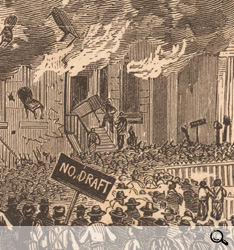

“Terrible Excitement throughout the City, resistance to the draft. Row of buildings on third Ave. burning down, also on Lexington Ave. Various other buildings fired by the mob. About 5 P.M. they appear before our factory Charles speaks to them and with the aid of Rev. Father Mahon they draw off....Charles gave the ringleaders $30-40 inc/n Money and one a check for $30. It was a terrible scene and we were of course all much exercised at the prospect of having the factory destroyed.”
—July 13, 1863, Diary Volume One
Witness to Participant in History
As the Diary progressed, William’s entries became more dense,
the script more hurried, as he rushed to detail his growing
participation in New York City life. In early years, he observed
some of the most dramatic events of the time, including the
fear and chaos of the 1863 Civil War Draft Riots and the city’s
intense mourning after the 1865 assassination of President
Lincoln. Endless meetings and events soon crowded William’s
days as he was asked to take an increasing role in many circles.
William’s business, civic, and social lives intertwined as his
stature increased, especially in the German American community
where his connections made him a powerful political ally. He
advised President Grover Cleveland on many appointments
and was a member of the Committee of Seventy tasked with
fighting the corruption of Boss William Tweed’s Tammany Hall.
Chairmanship of the city’s Rapid Transit Commission—known
as the Steinway Commission—charged William with developing
an underground transit system powered by electricity, a radical
idea for the time. Although entrenched interests thwarted
progress, William laid the blueprint for what would become the
New York City subway system. His Steinway Tunnel burrowing
under the East River takes today’s passengers between Manhattan
and Queens.
July 14–15, 1863, Volume One, Civil War Draft Riots in New York
Following the federal government’s institution of a military draft in New York City,
riots directed against the government and African Americans broke out in July 1863.
During this time, William, his elderly father, and his brother defended their factory
from mobs intent on destroying entire blocks of businesses and homes.
July 14th Tuesday.
"Early in the morning the trouble recommences, Soldiers
with Cannon marching down third Ave. An immense
concourse of people assembling near 34th extending from
2d to 5th Ave. terrible fighting between the soldiers and the
mob. Col. O. Brien killed, heavy fires in the eve. factory
stopped work yesterday and today. All business in the upper
part of the City suspended, Negroes chased everywhere &
killed when caught"
July 15th Wednesday.
fighting on 2d Ave near 21st street, the 7th and 71st Regts
arrive in the City more fighting on 2d & 1st Aves Stores
broken into and plundered. Citizens organizing for defending
private property, patrolling all night, burning of an Irish
shanty near Central Park. During the day I have walked down
to the store and back again in the eve. and watch all night
til nearly 5 O Clock A.M. in the shop. Find to my horror
that all the knapsacks of the 5th Regt has been moved to our
basements in the store. I have been unable to eat for the last 3
days except bread & drinking water for excitement.
From morning to night, William marshaled his stamina as he juggled commitments
to Steinway & Sons with those of German American groups, banking boards,
and powerful civic groups intent on achieving hotly debated goals in a period of
widespread corruption. His entries reveal his determination to forge ahead, hosting
one committee meeting at Steinway Hall on rapid transit, followed by another
focused on bringing the World’s Fair to New York City. When necessary, an ailing
William Steinway even presided over meetings from his bed.
May 19–26, 1890, Volume Eight, “Excessively Busy”
May 19th Mond.
As usual excessively busy. At 3 P.M. the Rapid Transit Commission meets...
May 20th Tuesd.
Am at Bridge Com. in afternoon and at L.K. in evg...
May 21st Wed.
In evg at Buildg Com. Deutscher Verein...
May 22d Thursd.
At Bk Metrop. Work home in evg
May 23d frid.
Rapid Transit Com. all meet at 107 E. 14th str. again; all present…Worlds Fair Meeting no Quorum
May 24th sat.
Excessively busy from morning til night at my office. Fine articles in the papers as I gave them to the press
yesterday. Work til late at Mansion...
May 26th Mond.
The work on me is terrific, an immense crowd of people pestering til 6 P.M. Home at Mansion working
Lexington Avenue in flames, Civil War Draft Riots, New York City, 1863
Courtesy of The New York Public Library, Astor, Lenox and Tilden Foundations

